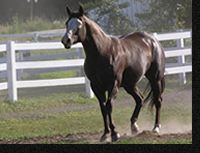We felt this would be a great way to share with everyone the process of breeding a mare through foaling to see what it took to get each mare through a breeding / foaling season. Each mare is very unique, keeping good records on each mare can benefit you down the road as many begin to have a distinct pattern.
Tea had an ultrasound in November which showed normal activity after her surgery to remove left ovary and a tumor the end of April. You will find the full story listed under Ovary Issues.
The most common approach to early breeding is to place the mare under supplemental light starting in late November or early December. You must convince your mare that spring has arrived by exposing her to artificially increased day-length. Light can be supplemented in the afternoon and evening to give a total of 16 hours light each day. The light should be bright enough for you to read the small print of a newspaper throughout the mare's housing area. Most mares will begin ovulatory cycles after about 60 days of light supplementation and will be ready to breed in February and March.
Both Tea and Maddie have been under a lighting program since November 1st, 2008.
Tea and Maddie, end of December 2008
"Kids Pine Tea" aka Tea
2004, 16 H, 1375 lbs, HYPP N/N |
"A Midnight Affair" aka Maddie
2003, 15.1 H, 1250 lbs, HYPP N/N, OLWs Positive |
A mare's estrous cycle, is the period between one ovulation and the next, is about 21 days long. Estrus, the time of sexual receptivity, occupies about seven days of the cycle. Unfortunately, the duration of estrus is extremely variable and can last anywhere from two or three days to two or three weeks. Diestrus, the period between two successive estrus periods, is more consistent in length and lasts about 14 to 16 days.
Starlight Ranch believes if you have a mare program and no stallion to tease your mare, your best form of evaluation is to rely on ultrasounds conducted by your vet as a way to keep close track of your mares. In 2009 since both Tea and Maddie were open we began monitoring them early January 2009. Doing these early checks allows you to have them ready for early February breedings incase there are issues, you have time to correct any issues before the breeding season begins.
January 8, 2009 Early Breeding Monitoring
Tea & Maddie Pre-Breeding WSU Vet Checks.
Tea In Full Heat, +++ Edema, 36 follicle on Right, should ovulate by the weekend. |
Maddie In Full Heat, Edema, 29 & 26 on Left, Multiple small follicle on Right, should ovulate by Monday. |
January 12, 2009 |
|
Tea In Heat, ++ Edema, 44 follicle on Right, HCG given, next check 1/14/09. Shedding heavily, excellent conditions. |
Maddie In Heat, lots
of average follicles, next check on 1/14/09. |
January
14, 2009 |
|
Tea Out of Heat,
Ovulated CL formed and + Edema |
Maddie In a Transitional
Heat, put on hormone injections |
The preparation is done and the breeding begins. |
|
